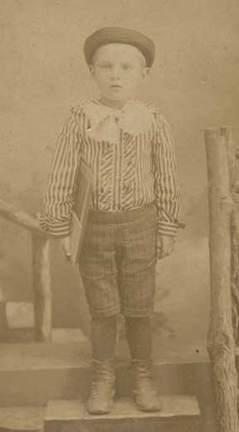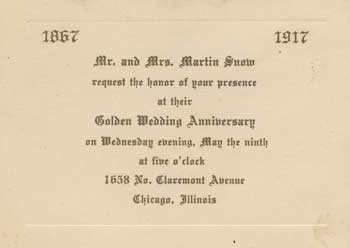4. Wedding Celebrations.

holding his writing slate.
The Children of Martin and Lena.
Three of the Schnee's six children died young including Julie, who was born 14 December 1882 and died on 30 January 1884. When his son Heinrich Werner "Harry" was born in 1886 Martin was a 43 year old finisher living at 69 Cornelia street. He is in the registered voter list in the 16th Ward having been naturalized by an Act of Congress, no doubt do to his service in the war.
The family moved to 1658 North Claremont where they are found in the 1900 census. They owned the home they shared with Lena's mother Maggie (Dewalt) Schwab. Their children, Maggie, 28, and Anna, 27 worked in a bakery. Henry was 13 and in school where he was taught the basics of reading, writing and arithmetic.
The 1908 Chicago City Directory has an entry for Martin "Snow", a woodfinisher. "Schnee" may be translated from German as "snow" and it appears he used both versions of the name interchangeably through the years. Henry, for his part, seemed to stick with the American translation beginning with his tenure as a clerk on Market street in 1903.
The 1910 census confirms Martin's service in the Union Army and his occupation as a furniture refinisher. Henry, 23, was a bookkeeper for Safeguard Accounting Company, an insurance company on LaSalle. Maggie married Roderick MacDonald in 1909 and they had a son, Henry, in 1911. Anna had married John Wolf in 1903. He was a novelty maker, and their daughter Margaret was five in the 1910 census. After he died she and her daughter went to live with her parents. Anna worked as a winder in an electric mill and 15 year old Margaret was a bookkeeper in a mail order house in the 1920 census.

Wedding Celebrations.
Henry Snow, 25, married Mae Walsh, 24, in St. Sylvester Catholic Church on 29 November 1911. Their wedding was the beginning of a long and devoted relationship. Father Michael O'Brien joined the two in the presence of their Best Man W.H. Gruner and Maid of Honor May Ryan. The Edwardian-style wedding dress Mae likely wore had a slightly high waistline with a close fitting sleeve.
An engraved invitation announced Martin and Lena's 50th wedding anniversary. It was celebrated at their home, 1658 North Claremont Avenue in Chicago, Illinois on May 9, 1917. In a family portrait taken around that time he is seen proudly wearing the badge of the Grand Army of the Republic.
Backlash From Foreign War.
While Martin had fought for his adopted country and had become a citizen, the US entry into the Great War in Europe war in April 1917 against Germany was cause for discomfort. Many German Americans had prayed that day would never come and hoped for continued neutrality. But with the sinking of the British ocean liner RMS Lusitania in 1915 anti-German sentiment grew. By 1918 headlines in the Chicago Tribune declared "German names must go...", and so they did. Street names in Chicago neighborhoods which long had reflected the ethnicity of the residents were renamed to erase any German connection. For instance "Rhine" street was changed to "Belden". Once hailed as an industrious and welcome addition to the country, those of the German race were now regarded with suspicion and disdain.
Harry was 30 when he registered with the draft board in June of 1917. He was an accountant for the world's largest insurance agency, Marsh & McLennan Company, located on Jackson Boulevard and 5th Avenue. Of medium height and build, he had dark brown hair and blue eyes.
For her part, Mae pitched in to help the war effort by volunteering in the knitting room at the Red Cross headquarters on North Wabash Avenue in 1918. Socks, sweaters and other necessary items were boxed and shipped overseas to the men serving in France. It was said the Chicago Red Cross produced more goods than any other branch in the country, thanks in part to the "prominent young society women".
- Chicago City Directory
- Chicago Tribune
- US Census Records
